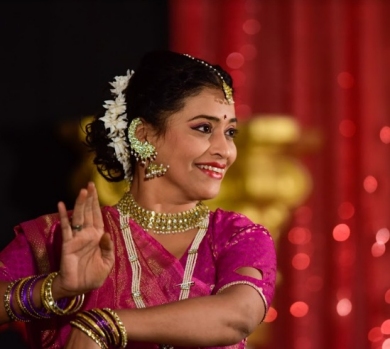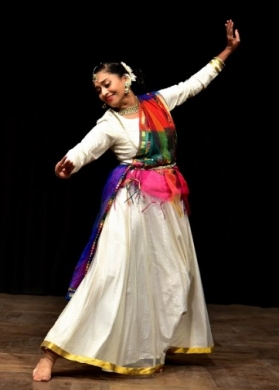
|   |

|   |
Kavitt Kaleidoscope - weaving rhythm, poetry and history - Dr.Anupma Harshal e-mail: anupma.anuphd@gmail.com October 14, 2020 A tribute to Pandit Lacchu Maharaj was paid through Kathak presentations that lasted a week, the event being curated by Sunil Sunkara. The celebration aptly called Guldasta-e-Kathak had the essence and colours of different aspects of Kathak. It saw the participation of several national and international artistes - Richa Srivastav (London), Rachit Tiwari, Simran Khurana, Paullumi Mukherjee, Guru Pratap Pawar, Dr.Padma Sharma and Tarini Tripathi, Kantika Mishra (Lucknow), Ragini Maharaj (Delhi), Karan Kishan (Nasik), Nikhil Ravi Parmar (Pune) and more. One of the notable presentations in this celebration was the Kavitt Kaleidoscope in Kathak presented by Gayatri Bhat, Kathak Faculty of the Art of Living Academy of Performing Arts (ALAP), Badlapur. Kavitta is the balanced equilibrium of Laya, Taal and Bhava - Nrityam laya taal bhava ashrayam that is also interpreted by many as presenting a story, an act or a narrative; many a times it has poetry woven into it. Gayatri Bhat, a fashion technologist, is a student of Guru Ranjana Phadke who is herself an erstwhile Kathak exponent. She set the tone of the day which was Ananth Chaturdashi by rendering a Ganesh Paran that was set to tune by young tabla artiste Swapnil Bhise and choreographed by Ranjana Phadke. The flow of the paran was flawless as it followed the rhythmic pattern of tate katan dha tit dha. A mellifluous tribute to Pandit Lacchu Maharaj in the form of the Ardhanari Nateshwar saw the amalgamation of ardha kati baghambar sohe, ardha bhuja shwetambar sohe, jai jai jai ardhang pati. The Kavitta has been sourced from the book 'Kathak mein Kavitta Chand' authored by Dr.Manjiri Deo. She beautifully presented both Shiva and Gauri, depicting the confluence of strength and poise.  The best part of the performance was the kavita presented on the backdrop of the pandemic situation. She used the analogy of the situation we are in today to that of the khand jati. The driving force for the creation of this piece was the disease all around us, forcing us into the present state of inertia. Set in khand jati, called so because it is khandit (into 3 and 2), made up of tisra (3) and chatushra jati (4) respectively, joining them to form 5 laghus. It was truly symbolic of our present condition, separation (social distance) and yet being connected (through technology). Being confined in our homes unable to meet, it has enabled us to remain connected by digital media. The presentation brought the beautiful choreographer in Gayatri to the fore who used her own experience to put forth the khand khand ho aaj jeevan, dhin takit dhin takit. She used the act to convey messages of washing hands, wearing a mask, being compassionate to each other and the role of music and dance to bond us together. Next was an intense Ganga kavitta where Bhishma wanted to meet Ganga once, lying on his death bed; however the backdrop of the war didn't allow the river to reach him. Parched and thirsty, he lay there while she was restless to meet him. Parth understood this agony and made way for the river to meet her son, who showered him in glory with the water blessing him as a mother would bid final adieu to her child. Simple movements, many characters and the portrayal of pain and restlessness were true to life.This kavitta composed by Gayatri along with Sunil Sunkara, Shruti Vaidya and Paullumi Mukherjee was part of a paper on 'Ganga, in the metrical patterns of Kathak' published by Kanishka publishers and distributed in Delhi. It features in the book 'Ganga Ki Sanskritik Swarlahariya' edited by Dr.Madhurani Shukla and Shambhavi Shukla.  The last note was a Mayur kavitta taka dhikit mayur mor, of how the dancing peacock enthuses an individual to dance like the free bird. The poetess expresses the desire of how watching the peacock dance in his own world, she too desires of wanting to let go her heart out in the rains. The composition has the counts of chatushra in tisra beats, nadhindhin nanadhin dhinnana dhindhinna. As tisra jati is one of the lively jaatis of Hindustani sangeet, it was selected for the composition to depict the freshness of monsoon and the dancing peacock. It ends with a beautiful nruttangi bol. Gayatri brought out a spectrum of emotions through her performance that was a treat to watch, delightful and original. The table sangat by Saurabh Paithankar added beautiful notes to her dance and padhant. Her renditions received choreographic guidance by her guru Ranjana Phadke. The Kavitt Kaleidoscope was an attempt to collate, and offer the audience a taste of well curated Kavitts in Kathak.The success of this initiative led Art of Living Academy of Performing Arts to continue Kavitt Kaleidoscope as a regular weekly feature to reach out to a wider audience and motivate students to take up a keen interest in both the learning and rendering of Kavitta in Kathak repertoire. The series incorporates interactions with maestros as well as performance videos. Dr. Anupma Harshal is a Research Scientist in Biology and has been trained in Kathak dance by late Pandit Brijraj Mishra. |